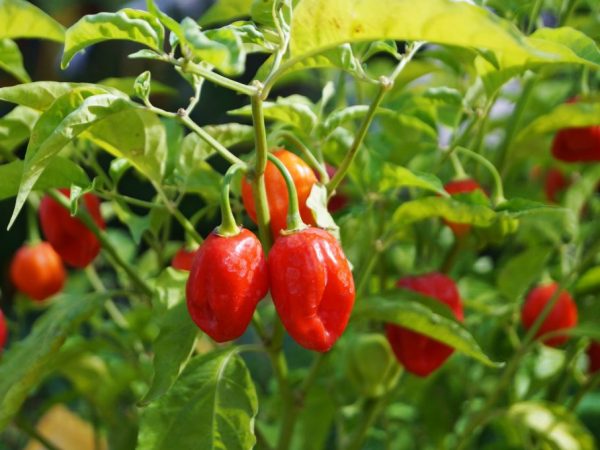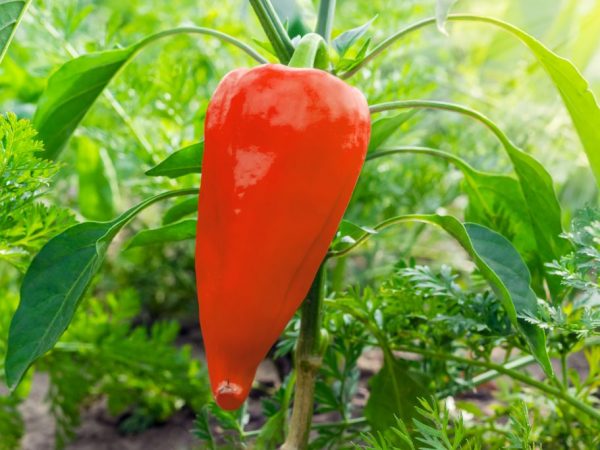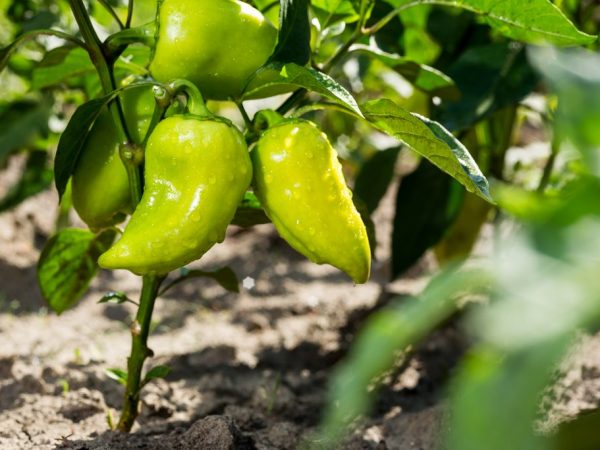The best varieties of pepper for open ground
In order for the cultivation of pepper in the open field to bring high yields, and the fruits had time to ripen in a short and not always hot summer, breeders bred varieties of pepper for open ground. They have qualities that make it possible to cultivate a vegetable in all weather conditions.
- How to choose a variety for open ground
- Ripening time
- The structure and height of the bush
- Resistance to adverse conditions and diseases
- Early ripe
- Asti Yellow
- Hercules
- Bullfighter red and yellow
- Belozerka
- Mid-season
- Gift from Moldova
- Veronica
- California miracle
- The best outdoor hybrids
- Gemini F1
- Claudio F1
- Samander F1
- Bitter pepper for open ground
- Conclusion

The best varieties of pepper for open ground
How to choose a variety for open ground
When choosing a variety, attention is paid to a number of qualities:
- ripening time;
- structure and height of the bush;
- resistance to drought, drops and drops in temperature;
- disease resistance.
Ripening time
For cultivation in northern regions with a sharply continental climate (Ural, Siberia), it is preferable to choose ultra-early and early-maturing varieties that ripen in 95-120 days. For regions with a milder climate (Moscow region, Central regions), in addition to early ripening varieties, mid-season varieties are suitable, which ripen in 125-140 days.
The structure and height of the bush
Best suited for growing in open beds, varieties of the determinant type with bushes up to 80 cm, highly developed stems and a powerful root system. During periods of bad weather, wind and heavy rains, undersized varieties are less susceptible to mechanical damage. Also, small bushes spend less energy on building up green mass, and energy is spent on setting and forming fruits.
Tall varieties require additional care: garters to supports, shaping and pinching.
Resistance to adverse conditions and diseases
In open ground, plants are more susceptible to the influence of atmospheric phenomena: cold rains, temperature changes. They negatively affect the process of nutrition, growth and maturation.
Resistance to various diseases is also important: it increases the chances of growing healthy plants without resorting to radical methods of protection.
Suitable for cultivation are unpretentious and disease-resistant varieties, as well as modern hybrids bred specifically for open ground.
Early ripe

Early maturing varieties are distinguished by high yields.
Early maturing varieties include varieties that ripen in 95-120 days. They have time to ripen in a short cool summer before massive blight by late blight.
Early bell peppers, intended for growing in open beds, must be sown for seedlings. The best time to sow seeds is mid-March to early April.
Among the early ones, the following are especially popular:
- Asti Yellow;
- Hercules;
- Toreodor is red;
- Toreodor yellow;
- Belozerka.
They are easy to care for and unpretentious to the place of cultivation, have a high and stable yield.
Asti Yellow
Icey Yellow - orange high-yielding sweet pepper of an early ripening type of Italian selection.Bushes are powerful, up to 55 cm, with a strong central stem and medium branching. The first ripe fruits are harvested within 80-90 days after planting the seedlings.
Peppers grow large, weighing 210-300 g, with juicy walls 0.7-1 cm. Their shape is four-section, cubic. The harvest begins at the stage of technical ripeness, when the pepper has already gained mass and acquired a green or light yellow color.
Asti Yellow has a sweet taste and crispy flesh.
The variety is resistant to diseases typical of nightshades, easily adapts to short-term drought and temperature drops.
Hercules
Large-fruited early ripening variety ripens 75-85 days after planting in the ground. Plants are open - up to 0.6 m. The root system is highly developed. The fruits are large, weighing up to 300 g. The walls are fleshy, up to 10 mm. The shape is cubic, with 4 clear chambers. The fruit turns red when fully ripe.
When the temperature drops, the variety does not throw off flowers and ovary. Among the disadvantages are the need to tie the bushes to the support.
Bullfighter red and yellow
Early bell pepper, ripening begins on day 95-105. Low-growing bushes 35-55 cm with strong lateral stems. High-yielding, 14-17 peppers with a weight of 120-150 g are tied on the bush. The walls are dense, of medium thickness (0.6-0.7 cm).
According to the description, the Toreodor has a spherical, slightly ribbed shape. The fruits are well preserved, do not lose elasticity, rarely get sick with rot and late blight.
Belozerka
Belozerka is a popular ultra-early (90-100 days) variety of sweet peppers; it has been grown for more than one year both on individual household plots and on farm lands for industrial purposes. It is unpretentious to the place of cultivation, resistant to pathogens and pests.
Bushes are erect, 0.6 m in height. Fruits are cone-shaped, weighing 60-90 g. About 4 kg of pale yellow fruits are harvested from one bush. The flesh is crispy, 5-7 mm. Belozerka is a versatile variety, the fruits are widely used for industrial processing and freezing.
Mid-season

Good plant care ensures a bountiful harvest
These are peppers that ripen in 120-140 days. If you sow seeds for seedlings on March 5-10, mid-ripening peppers ripen only a few days later than early-ripening ones. Mid-ripening ones are distinguished by large fruits with thick walls.
Gift from Moldova
Gift from Moldova is the most popular and well-known variety cultivated in many regions. According to the description, its bushes are of the standard type, 45-65 cm high, with strong stems. 8-12 fruits are tied on the plant. The yield is regular and stable, which allows you to collect an average of 5 kg per 1 sq. m.
Ripe fruits turn bright red with a glossy sheen. Fruit weight - 150-200 g, conical shape, gradually narrowing towards the end. The gift from Moldova is used raw, as well as for making lecho, adjika and other dishes.
The variety is not prone to fusarium disease, copes well with negative factors during the period of worsening weather conditions.
Veronica
Veronica is a productive high-yielding variety. On a medium-sized, strong bush (60-70 cm), 12-15 fruits weighing 300-400 g are tied.
Ripening occurs 130-145 days after germination. The fruits are juicy, thick-walled, with a uniform crunchy and sweet pulp, and have a rich cherry color. They are intended both for fresh consumption and for processing.
Among the advantages are:
- high productivity;
- stress tolerance;
- good portability;
- ease of care;
- lack of exactingness to the garter.
Veronica grows well and bears fruit even with a thickened planting, So, for 1 sq. m planted up to 7 bushes.
California miracle
This famous variety has not lost its leadership position for many years, and many gardeners prefer the California miracle to modern hybrids.As simple as possible in agricultural technology, the variety is perfectly cultivated in the unprotected soil of the middle lane, has a high yield, stable fruiting even under unfavorable conditions.
The bush is strong, from 50 cm in height, does not require a garter even when it reaches a height of 1 m. From 10 fruits are formed on the bush in the form of a cube with 4 chambers. Fruits are uniform, of medium size, weighing 100-150 g. The color of ripe fruits depends on the varieties of the variety and varies from bright yellow to deep red. The skin has a beautiful, even surface with a glossy sheen. The structure of the pulp is homogeneous, crispy. The California miracle is close in characteristics to hybrids.
The best outdoor hybrids

Hybrids will delight with large fruits
Many hybrids of modern breeding are adapted for growing in open ground and greenhouses.
Among the most famous and popular varieties, the following are distinguished:
- Gemini F1;
- Claudio F1;
- Samander F1.
These are early maturing high-yielding varieties, the fruits of which are large in size and excellent taste. The only drawback of hybrids is the need to purchase seeds every year, because it is not always possible to obtain an identical maternal crop from seeds obtained from grown fruits.
Gemini F1
An early, highly productive hybrid of Bayer Nunhems Gemini F1 intended for outdoor use. It has compact erect bushes up to 0.6 m high, well leafy, which protects the crop from sunburn. On the stem, up to 10 peppers of a bright yellow color, weighing 350-400 g, are formed. Fruits are elongated, cuboid-shaped, large in size, reach 18 cm in length, and about 9 cm in diameter.
The fruits ripen in 70-75 days from the moment of planting young bushes in open ground.
During storage, if the temperature regime is observed (2-5 ° C), the variety does not lose its characteristics for about 30 days.
The bushes are resistant to drought, heat, and short-term sharp drops in temperature.
Claudio F1
The hybrid variety is intended for cultivation in open beds and greenhouses, is famous for its yield and is one of the thickest-walled sweet peppers. 10-12 fruits are tied on the bushes. They begin to ripen in 75-80 days from the moment the seedlings are planted.
The fruits have an elongated cuboid shape, four-chambered, bright red. Their average weight is from 200 g, wall thickness is up to 15 mm. The fruit grows in length about 14 cm.
The variety is resistant to a number of diseases:
- to the mosaic;
- to the potato virus;
- to tobacco mosaic.
It tolerates long-term transportation and storage.
Samander F1
The very early high-yielding hybrid Samander F1 is successfully cultivated in unprotected soil. It is distinguished by a record-breaking fast ripening, in a state of technical maturity, the fruits are removed 50-65 days after planting the seedlings.
A feature of the variety is its ability to tie up to 20 fruits weighing 140-200 g on a bush even under unfavorable conditions (drought, temperatures below 22 ° C).
Samander fruits are distinguished by an elongated-conical shape. When fully ripe, the peppers turn deep red. In length, they grow up to 20 cm. This hybrid is transportable and well stored, grown for industrial purposes.
Bitter pepper for open ground
A distinctive feature of many varieties of hot peppers is that they are less demanding on growing conditions. It is easier to cultivate them outdoors.
When choosing hot peppers, they pay attention to the external and taste qualities.
The following varieties of high quality hot peppers are distinguished:
- Adjika;
- The Queen of Spades;
- Dragon's tongue;
- Bully;
- Witty;
- Super chili.
Hot peppers are easily adaptable to conditions, stress-resistant and require minimal maintenance. It is necessary to sow seeds for seedlings in early spring, and when planting in a garden, remember about the ability of bitter peppers to pollinate sweet peppers, so it must be planted at a distance or separated by corn planting.
Conclusion
Growing tasty and large peppers outdoors is not difficult at all. A wide range of varieties and modern hybrids adapted for this growing method provide a positive result. And focusing on the basic qualities that pepper should have for planting in a garden, you can easily choose the ideal variety for your own garden.

